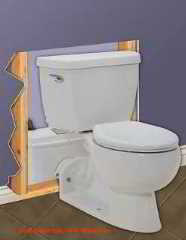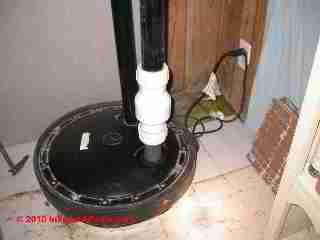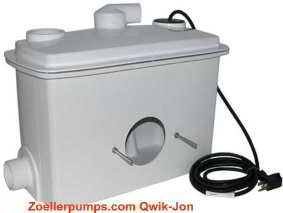 Basement & Up-Flush Toilets
Basement & Up-Flush Toilets
Toilet types & ejector pumps for use below the main drain
- POST a QUESTION or COMMENT about basement toilets or toilets located below the building's sewer piping
Guide to types & designs of toilets used when the toilet must be located in a low area below the building's main drain or sewer line.
Page top illustration: the Zoeller Quik Jon that includes a built-in sewage grinder pump, discussed in this article.
This article series describes the different types and models of toilets: historical or old toilet types, wooden high wall-tank toilets, conventional reservoir tank toilets, low-flush toilets, water saving toilets, back-flush toilets, up-flush toilets, and even chemical toilets.
InspectAPedia tolerates no conflicts of interest. We have no relationship with advertisers, products, or services discussed at this website.
- Daniel Friedman, Publisher/Editor/Author - See WHO ARE WE?
Basement & Other Up-Flush Toilets for Toilets Located Below the Sewer Piping, No Toilet Tank
A variation on the flush valve toilet is the up-flush toilet used in bathrooms whose toilet was located below the building's sewer line exit to the sewer or septic system.
An up-flush toilet relies on building water pressure to force the waste from the toilet up to a higher sewer line.
Because an up-flush toilet that relies on building water pressure to work forms a cross connection, these toilets are not permitted by plumbing codes in most jurisdictions.
In our photo of an up-flush toilet you can see the flush control lever mounted on the wall at the upper right.
Like the modern flush-valve toilet shown above, the up-flush toilet is also a back flush or rear-flush model. But don't confuse the two.
The flush valve toilet shown above does not form a cross-connection, drains into a gravity-sewer line rather than an elevated sewer line, and it is permitted by current plumbing codes.
Basement Toilets Using a Sewage Ejector Pump
Bathroom fixtures including toilets located in buildings whose sewer line exits high on the basement wall need a means to raise the graywater (sinks, tubs, showers, laundry) as well as blackwater or sewage from a toilet up to a height sufficient to drain into the sewer line and leave the building.
A residential sewage ejector pump is the most common solution to this need.
The sewage ejector pump combines a small reservoir tank, a sewage grinder pump, and piping to grind and then pump sewage and wastewater from (usually) below floor level (such as in a basement) up to an elevated sewer line that then leaves the building.
Our photo (left) shows a typical basement installation of a sewage ejector pump. The toilet connected to this pump is not shown, but was located mounted on the floor nearby. A drain from the basement toilet was routed below the floor slab over to the black plastic holding tank shown in our photo.
The white valve in the photo center, above the sewage pump's tank top, is a check valve to prevent wastewater from flowing backwards into the pump from above.
In a plumbing system using a sewage ejector pump, typically all of the plumbing fixtures (sink, tub, shower, laundry sink, clothes washer) drain under the building floor by gravity into the sewage ejector pump reservoir.
When the wastewater level in the ejector pump reservoir reaches a sufficient level, a float turns on the pump, forcing the wastewater past a check valve, upwards to the building sewer piping.
Depending on the arrangement of building piping, we sometimes find sewage ejector pumps that are located with the top of the unit a bit above floor level - possibly reducing the available storage volume between pump operation cycles.
Watch out: in the event of an electrical power failure, sewage grinders or sewage ejector pumps won't be working unless you have a backup electrical power source. So don't count on continued use of plumbing fixtures connected to one of these devices when there is no electricity.
Graywater ejector pumps: Also, don't confuse a sewage ejector pump with a GRAYWATER PUMP or lift pump [photo] that is sometimes found installed to move graywater from a basement laundry up to the building sewer drain.
For more detail about types of septic system pumps
see SEWAGE EJECTOR / GRINDER PUMPS.
Zoeller Quik Jon combines sewage ejector pump & toilet
The Zoeller Pump Company produces a residential toilet that can be free-standing or built-in, and that combines an integrated mini-grinder pump with a rear-flush toilet. The sewage grinder/ejector pump can also support a lavatory, bathub, and-or shower.
Above our first image, courtesy of Zoeller Pump Company [permission request made] shows the back-flush toilet with supporting grinder pump tank in the wall cavity behind the toilet itself. The second image shows Zoeller's grinder pumping chamber for this system.
- Zoeller Pumps, "Qwik Jon® Ultima" sewage system (toilet + integrated sewage pump), Zoeller Pump Company, 3649 Cane Run Rd.
Louisville, KY USA 40211
Phone: +1-800-928-7867
Phone: +1-502-778-2731
Fax: +1-502-774-3624
Product Support: zcotechnical@zoeller.com,
Zoeller® Canada 975 Bleams Road, Unit #5 Kitchener, Ontario N2E 3Z5 Phone: 1-877-710-7867 519-804-2281 Fax: 519-748-5059 Email: stuarts@zoeller.com,
Zoeller® Mexico Phone:+52 (33) 1657-3176 Email: patrickf@zoeller.com,
Zoeller® Taiwan (Asia Pacific) Phone: +866-2-2908-8000 Fax: +886-2-2908-3100 Email: sales@zoeller.com.tw,
International Sales Manager (Europe/Middle East/Africa) Jason Meyer Phone: +1-502-778-2731 ext. 8159 Fax: +1-502-774-3624 Email: jasonm@zoeller.com,
Latin America Sales Manager Carlos Trujillo Phone: +57313-745-11-92 Email: carlost@zoeller.com, retrieved 2017/03/25, original source: https://inspectapedia.com/plumbing/Air_Admittance_Studor_Vents.php
...
Continue reading at SEWAGE EJECTOR / GRINDER PUMPS or select a topic from the closely-related articles below, or see the complete ARTICLE INDEX.
Or see these
Recommended Articles
- SEWAGE EJECTOR / GRINDER PUMPS
- TOILETS, INSPECT, INSTALL, REPAIR - home
- TOILET FLUSH OPERATION
- TOILET INSTALLATION PROCEDURE
- TOILET MANUFACTURERS & SOURCES
- TOILET REPAIR GUIDE
- TOILET TYPES, CONTROLS, PARTS
Suggested citation for this web page
BASEMENT & UP-FLUSH TOILETS & EJECTOR PUMPS at InspectApedia.com - online encyclopedia of building & environmental inspection, testing, diagnosis, repair, & problem prevention advice.
Or see this
INDEX to RELATED ARTICLES: ARTICLE INDEX to TOILET INFORMATION
Or use the SEARCH BOX found below to Ask a Question or Search InspectApedia
Ask a Question or Search InspectApedia
Try the search box just below, or if you prefer, post a question or comment in the Comments box below and we will respond promptly.
Search the InspectApedia website
Note: appearance of your Comment below may be delayed: if your comment contains an image, photograph, web link, or text that looks to the software as if it might be a web link, your posting will appear after it has been approved by a moderator. Apologies for the delay.
Only one image can be added per comment but you can post as many comments, and therefore images, as you like.
You will not receive a notification when a response to your question has been posted.
Please bookmark this page to make it easy for you to check back for our response.
IF above you see "Comment Form is loading comments..." then COMMENT BOX - countable.ca / bawkbox.com IS NOT WORKING.
In any case you are welcome to send an email directly to us at InspectApedia.com at editor@inspectApedia.com
We'll reply to you directly. Please help us help you by noting, in your email, the URL of the InspectApedia page where you wanted to comment.
Citations & References
In addition to any citations in the article above, a full list is available on request.
- Our recommended books about building & mechanical systems design, inspection, problem diagnosis, and repair, and about indoor environment and IAQ testing, diagnosis, and cleanup are at the InspectAPedia Bookstore. Also see our Book Reviews - InspectAPedia.
- In addition to citations & references found in this article, see the research citations given at the end of the related articles found at our suggested
CONTINUE READING or RECOMMENDED ARTICLES.
- Carson, Dunlop & Associates Ltd., 120 Carlton Street Suite 407, Toronto ON M5A 4K2. Tel: (416) 964-9415 1-800-268-7070 Email: info@carsondunlop.com. Alan Carson is a past president of ASHI, the American Society of Home Inspectors.
Thanks to Alan Carson and Bob Dunlop, for permission for InspectAPedia to use text excerpts from The HOME REFERENCE BOOK - the Encyclopedia of Homes and to use illustrations from The ILLUSTRATED HOME .
Carson Dunlop Associates provides extensive home inspection education and report writing material. In gratitude we provide links to tsome Carson Dunlop Associates products and services.




